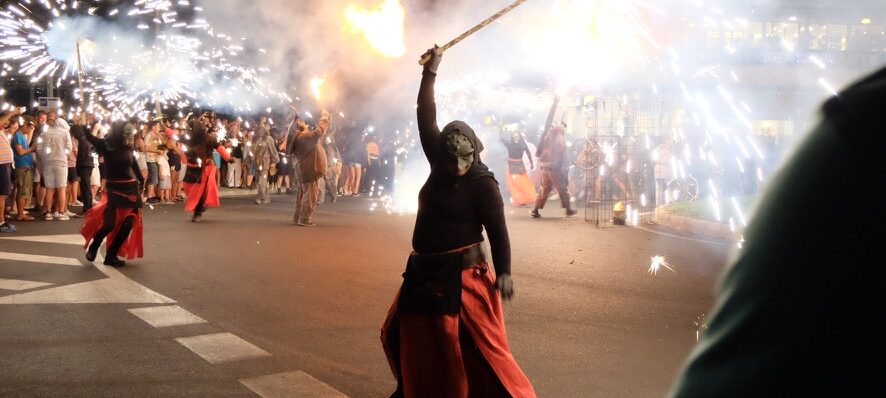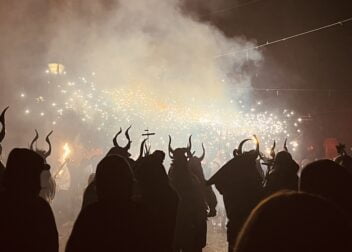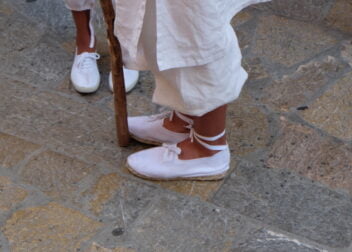Fiestas in Mallorca: 12 jam-packed months of local culture
- 4 June 2024
- Things to do, Fiestas & Events, Uncategorized
- 17 mins read
Here is a quick guide to fiestas in Mallorca, more specifically to the parties, fairs, annual cultural activities and other major events in the North of Mallorca. It’s worth noting the following points: Actual dates may vary each year (like, of course, Easter). The main dates given here are the final day, e.g. the relevant saint’s day. For the big fiestas in Mallorca there is normally a big build up with a good week’s worth of activities beforehand. For all this information, check back on our website where local information will be updated as soon as the programmes are released. To see upcoming events visit our What’s On page.
Table of Contents
Fiestas in Mallorca Month-by-Month
January
The Kings' Parade
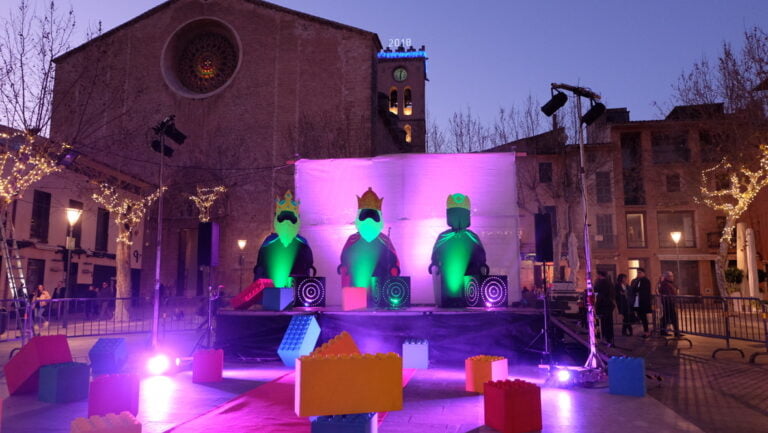
5th January
This is what the children have been waiting for all year. This is how the Spanish do Christmas. On the days preceding the 5th, Pages arrive in town on horseback to receive wishlists from the children of the town. Letterboxes for each of the kings are dotted about town for them to post too. On the big day, the 5th January, the Kings arrive parade-style and scatter sweets from their floats. Once in situ, the children go and say hi. It’s like a trip to see Santa. Then that night, their gifts are left “on the doorstep” for them to find in the morning. In some towns, it’s possible for residents to sign up and actually have the Kings arrive at the door with your actual gifts. Check on local council websites.
Sant Antoni
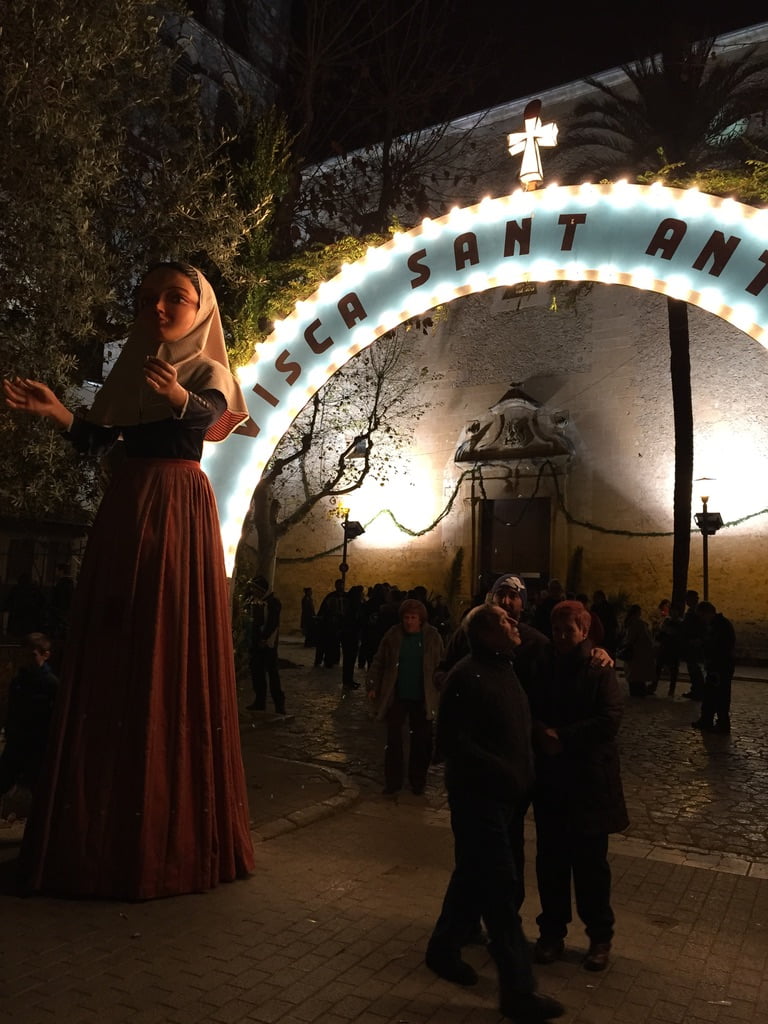
17th January
One of the most eagerly anticipated fiestas of the whole year, Sant Antoni’s is celebrated everywhere in the north. Sa Pobla is the ‘big one’, so big that its Nit Bruixa (the witch night) attracts so many people from across the island that the town is packed to the rafters. Crowded, chaotic, scary and loads of fun, the demonis run in the streets all afternoon and the dance of the Caparrots (the Giant Heads) is held at night. The day ends with a huge fireworks display. Muro is a good alternative. It has a demons’ spectacular but is not as crowded, and the party there goes on until past midnight with bands playing in different squares. In Alcudia the demons do their dance too and in Pollensa Old Town, the demonis hold a huge correfoc the weekend before. Bonfire competitions are held in each of the towns.
On the day of Sant Antoni, all the towns have blessings for animals, where residents congregate in town with their pets and pass by the church for the holy water to bless them. In Sa Pobla and Muro there are also parades of floats. Pollensa, while it does have the traditional animal blessing, it also has its own Sant Antoni traditions – El Pi, The Pine. By 11am, everyone begins their walk to the Ternelles valley to pick up the Pine, a tree felled a few weeks before in the woods and prepared and placed on a cart ready for its big day. The town gathers in and around the pine and have lunch – a giant community picnic laid on by the council of bread, tomatoes, olives and sardines. At about 14-14:30 everyone gets together to drag the tree into town on a carriage. Upon arrival the 30-metre smooth and slippery Pine is stood up in the Plaza Vella ready to be climbed by anyone daring enough. The winner gets a prize but the pride and fame is just as valued. Puerto Pollensa has its own version where a pine tree is dragged by a boat via the sea from the Formentor beach. Once back on land it is taken to the main square, erected and climbed in the afternoon.
San Sebastian
20th January
This fiesta – another with bonfires aplenty and torrades (communal barbecues) in the street – is not a huge one in the north. This is Palma’s gig. However, there are a few bonfires marking the occasion. In Pollensa there is the traditional procession with mock horses – the procession of “cavallets i l’estendard”. While the horses (men inside handcrafted horses) dance along the route, the flag is flown and waved behind. They then gather for the final dance by the bonfire in the main square and there is mass in the church.
February
Carnival
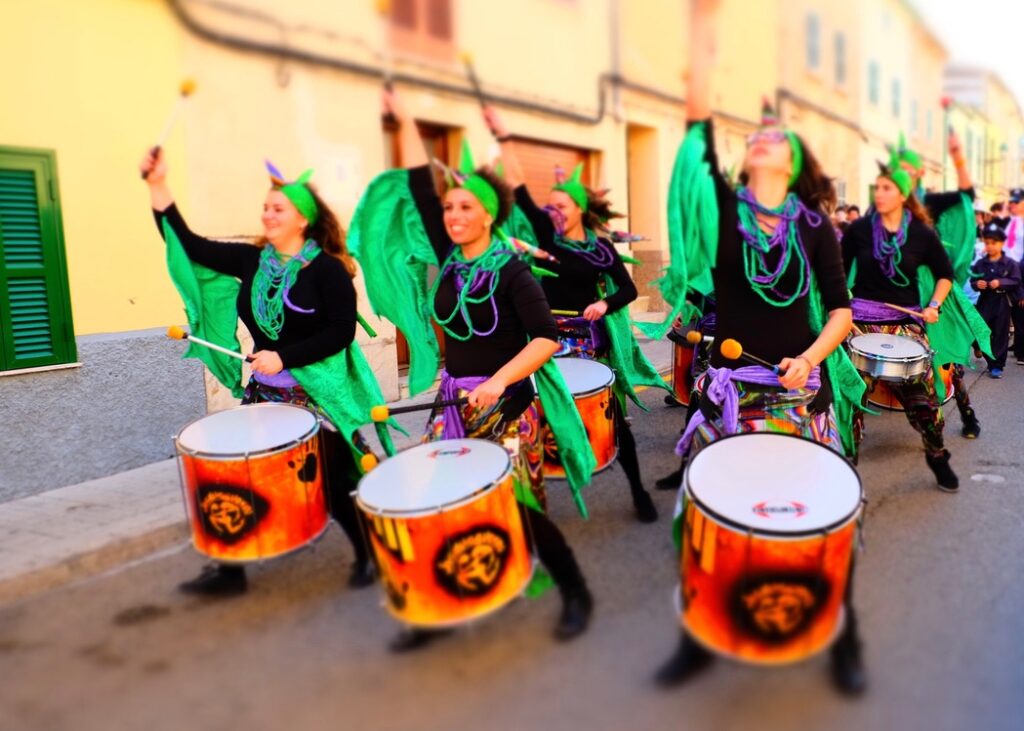
February/March
A different day every year, you can rely on the last weekend before Lent to be full of fancy dress parties and silliness as well as parades of themed floats. Always good fun, there are parades during the week from all the local schools and by the end of the week, as well as the main Rua (parade) of the town, parties for the grown ups get into full swing. Check locally for posters with all the information. As well as on our very own What’s On page.
Fira de Santa Margalida
This is an agricultural and craft fair which is normally held to coincide with Palm Sunday, and a traditional blessing of the palms is a feature of the fair.
Easter
This really needs no explanation, other than to point out that Pollensa does Easter more dramatically than elsewhere in the north with an impressively sombre procession on Holy Thursday and the descent – el Davallament – with the cross down the Calvari Steps on the evening of Good Friday. If you are in Pollensa for Easter do not miss this spectacle.
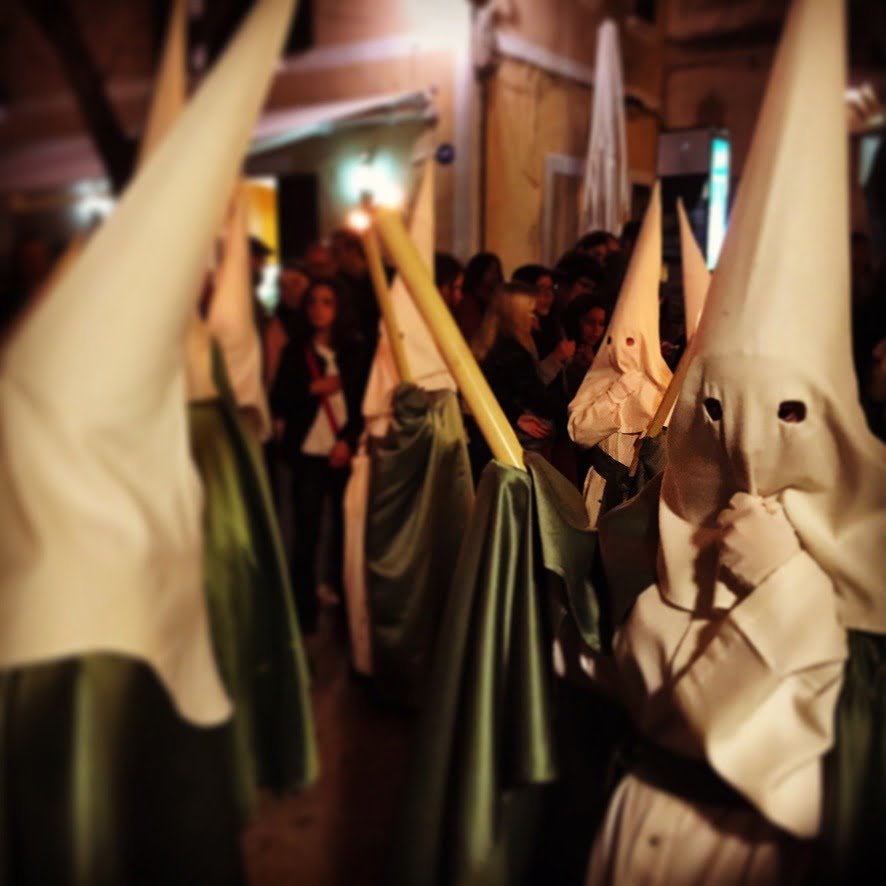
April
Fira de Sant Francesc, Muro
Since the end of the 18th century, just after Easter, the streets around the Convent de Mímins have been full of festivities and noise. Originally, the fairs meant a change of routine and an opportunity for farmers to buy products that were not normally available to them. Today things have changed, instead the fair has become an exhibition of a wide range of products and handicraft. A big highlight of the Fair Programme is the traditional descent of the rabbit, on the soapy pole, which is held on the Saturday evening before the main day.
Feria de Abril
Celebrating the spring and all that it brings, the various Feria de Abril that are held in towns in the north deliver a touch of Andalusia to Mallorca. Originally an agricultural fair, these have become one of traditional dance, music and costume. Expect stunning displays of flamenco dress and music. Traditional singing and dance are a highlight.
Nautical and Sepia Fair - Puerto Alcudia
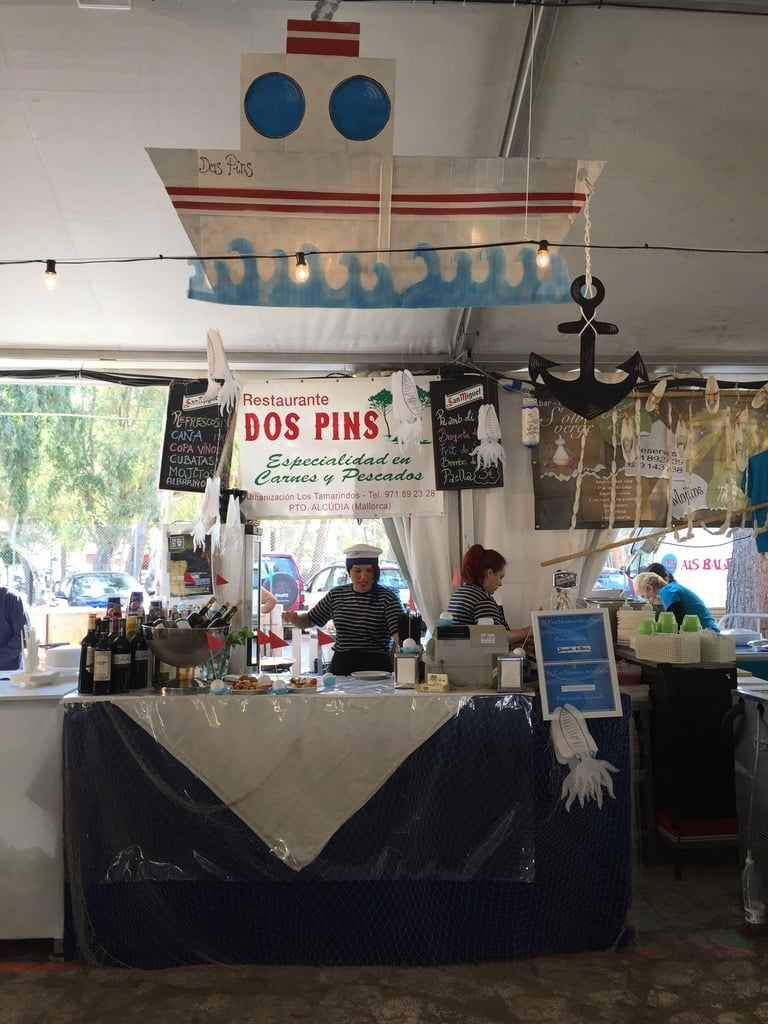
Puerto Alcudia’s Nautical and Sepia Fair brings gourmands and sea enthusiasts together as the port town is brought alive with a food hall with local restaurants showcasing their own sepia (cuttlefish) dish, artesan stalls, a boat fair and an agenda full of cultural activities – the traditional dance on the promenade is always a favourite.
Dia de Sant Jordi - St. Georges Day
23rd April
Something that rings bells with the Brits, St. Georges Day is a thing in Mallorca too. Here, the emphasis is on the gifting of a red rose to women (as St. George himself did) and the gifting of a book to the men (as the distressed damsel gave to her hero St. George). Literary events and book sales are held all over.
May
La Fira des Jai, Buger
One of the smaller yet most traditional fairs in the north of the island is that of the little village of Buger. La Fira des Jai was reintroduced in 1977 and reenacts the arrival of the children of the town’s grandparents as they return from the fairs of Inca and Sineu. A week of activities leads up to the main event when the children line the streets to welcome the grandfather who arrives by horse and cart and hands out sweets to the little ones. Usually at the beginning of May, check locally and on our events pages for up to date info.
Fira de Campanet
An agricultural fair complete with livestock as well as a market for local artisans.
June
Corpus Christi, Pollensa
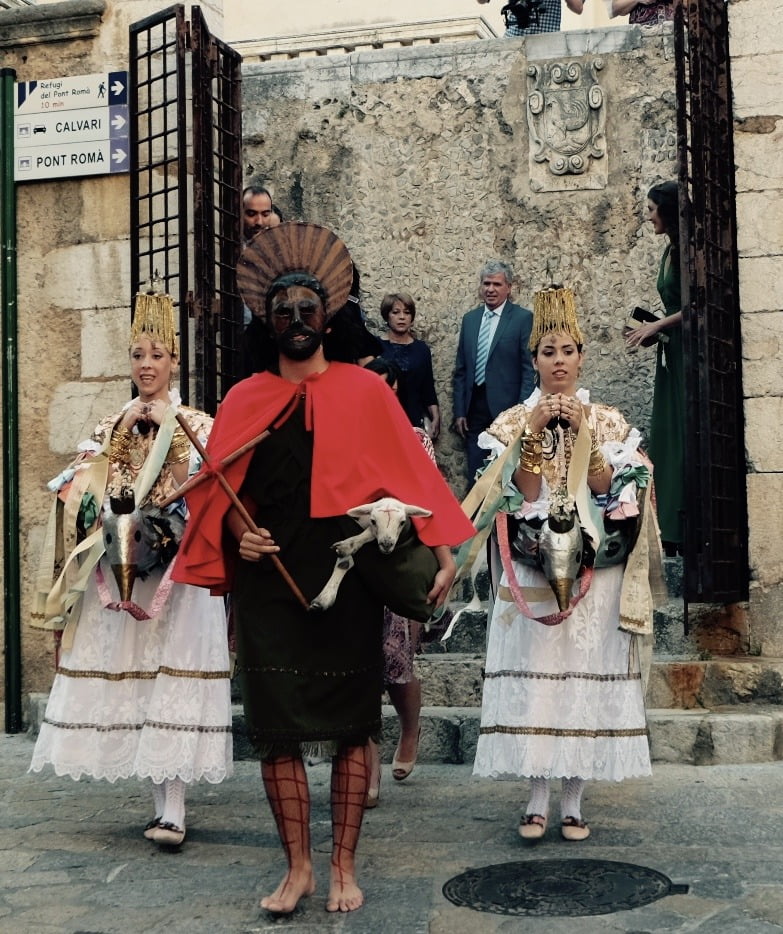
Celebrated the Thursday after Trinity, 60 days after Easter, Pollensa is the only village in Mallorca where this religious fiesta is celebrated. Much like the horses of San Sebastian, it’s a quirky one, two young women and a young man from the town perform the Dance of the Eagles and Sant Joan Pelos in the streets of the town. The costumes, the jewellery, the entourage that follow (family of the two eagle dancers) make this a site to behold.
Night Fair of the Potato, Sa Pobla
If there’s one thing that Sa Pobla is famous for, it’s the potato! Not uncommon to find a sack of Sa Pobla potatoes in M&S or Waitrose in the UK, they are the real thing and in June there is a mini-fair just to prove it. Different bars and restaurants around the town come together and offer their own specialities in a night market in the main square. Expect traditional, avant garde and everything in between, the little dishes go for around €2-4 each.
San Juan, Muro
24th June
With a calendar of events two-weeks long, this popular festival in Spain happens to be Muro’s Patron Saint’s Day. The town is abuzz until the culmination on June 24th when there is a huge fireworks display on the Passeig de Sa Riba. Standout events include the Sopar a la Fresca, when local residents move their dining tables outside and eat on the street with their neighbours; and the 40 Voltes, where runners chase around the main square 40 times. A real test of endurance and sheer courage those who participate are within touching distance of the crowds lining the ‘track’.
Sant Pere, Puerto Alcudia
29th June
An important date in Alcudia’s cultural agenda, St Pere is the Patron Saint of sailors, and as fishing is deeply rooted in the community of Puerto Alcudia this has become something of a Patronal Fiesta in the port town. On 29th June every year a flotilla of decorated boats sails along the bay with the statue of Sant Pere. Activities begin the week before in the port, and include parades, parties and musical performances.
July
Fiesta de la Mare de Déu de la Victòria, Alcudia
1st-2nd July
This is a very Alcudia affair featuring a pilgrimage to the mountain hermitage of La Victoria. You don’t get any DJs pumping out music after midnight. Folk dance, rum, paellas, camomile offerings are the order of the day. On the 1st, everyone walks up to La Victoria where traditional dance and music continue through the night. On the 2nd, cannons are fired at 8:30am and the hike up starts again. Mass is held and chamomile is handed out, more traditional music and dance carry on in the afternoon.
Campanet has its own Sant Victoria celebrations with a programme of events lasting a week or more.
Fiestas de la Virgen del Carmen, Puerto Pollensa
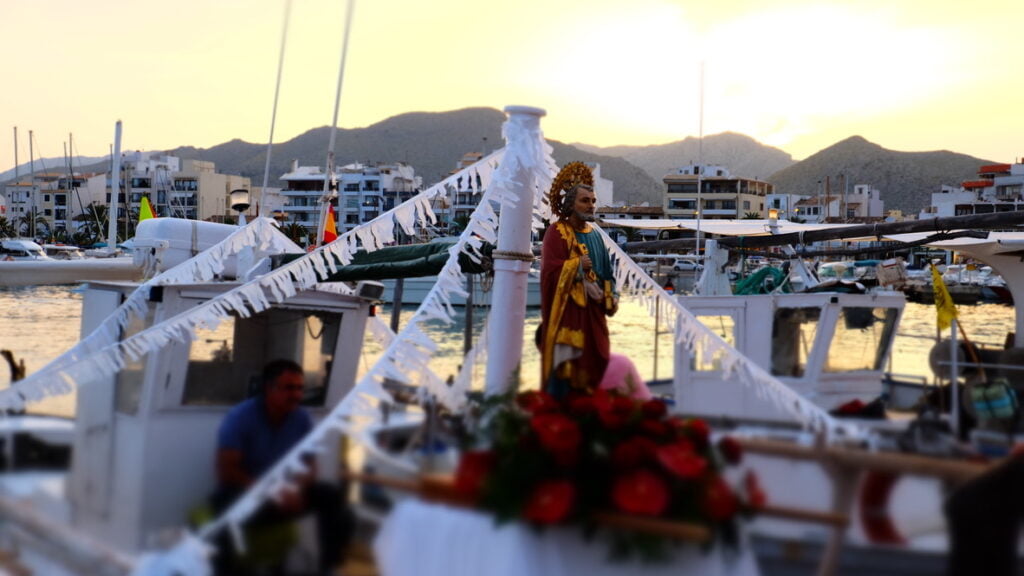
16th July
The Patrona Fiesta for Puerto Pollensa, this is another week-long affair with cultural activities in the square and parties along the beach. The popular Marinara Race is a quick 7.5km race along the front and its after-party has become a highlight. Culminating on the 16th, the Virgen del Carmen features a pretty flotilla with the image (or statue) of the Virgen del Carmen and ends with a dazzling Correfoc (fire running by the demonis) and an amazing fireworks display at midnight. Not to be missed.
Santa Margalida and Sant Jaume, Sa Pobla
Throughout July
Two fiestas rolled into one, the last half of July sees the celebrations for these Saints in Sa Pobla. Popular sports and cultural activities are organized, including conferences, art exhibitions, the Poetic Crestatx, a Choral concert and a Tortilla competition. At weekends traditional musical revetllas take place in the Plaza Major. A recent addition to the programme is the Brutal Running race, a Tough Mudder or Spartan style event, and the Cap de Bou de Talapi set of celebrations. The Cap de Bou de Talapi is an ancient brass bulls head, which was discovered in the 1950s on Finca Talapi and the mini-fiesta has been a part of the Santa Margalida and Sant Jaume celebrations since 2017.
Sant Jaume, Alcudia
25th July
The old town of Alcudia’s annual fiesta is in honour of the town’s patron, Sant Jaume. A feature is the “We are citizens of Pollentia”, a celebration of the Roman past that includes a special party in honour of Roman gods. By special party, one means DJs from 11pm. The fiesta ends with the Gegantes and fireworks display.
Playa de Muro Fiestas
End of July
A four-day programme of music and dance, parties for the kids and displays from local lifeguards, the Playa de Muro fiesta is held on the beautiful beaches.
August
La Patrona, Pollensa
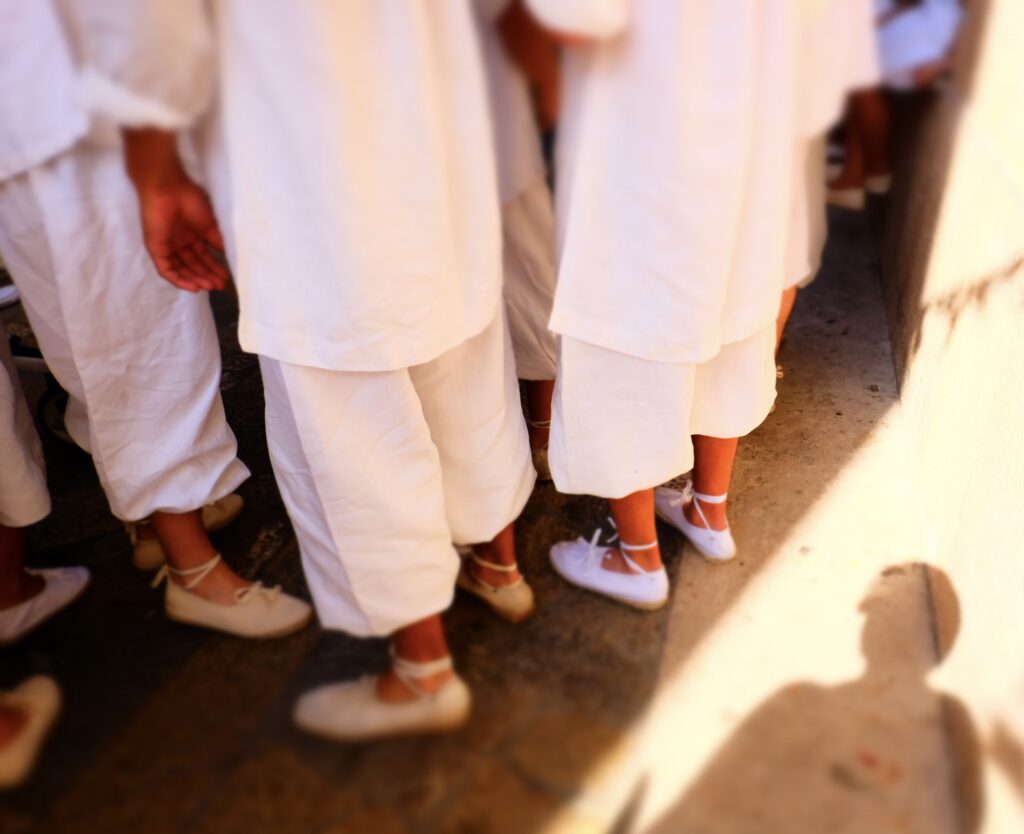
2nd August
The greatest of the summer fiestas in the north, this is a televised event and people from across the island flock to Pollensa to see it. A week of partying and frivolity lead up to the main day which entails a mock battle between the town’s hero, Joan Mas, and invading pirate Dragut and his crew. The town is out in traditional dress and the battle moves through the town until Joan Mas wins again and runs back to the church for a service of thanks and then a truly rousing rendition of Visca Pollença.
Festival of Pollensa
Throughout August
The annual Festival de Pollensa began in 1962 at the hands of distinguished English violinist Philip Newman. Now more than 60 events later, Pollensa has played host to over 800 of the finest classical artists in the world. Performances, ranging from string quartets to opera, from symphony orchestras to soprano soloists, are held at the stunning Claustre de Santo Domingo, a historic venue that provides excellent acoustics, while the audience enjoys the summer evening air.
Jazz Festival, Sa Pobla
Throughout August
This prestigious jazz festival takes place in the Plaza Major in Sa Pobla. An annual event, and running for more than 20 years, the festival has seen great international jazz figures, such as Ravi Coltrane Quartet, Charlie Haden Quartet West, Bill Frisell, Ana Popovic Blues Band, John Zorn, Joe Lovano perform in the town.
Fiesta de Cala San Vicente
Mid August
As is typical of this type of celebration, the Cala de Sant Vicenç festivities include sporting, recreational, cultural and religious events. Although, initially, these festivals were celebrated during the month of July, they are now organized in mid-August. These are the last summer festivities in the municipality of Pollença, and the programme usually includes a concert in Cala Molins, which is the most popular event.
Mare de Déu d'Agost Fiestas, Can Picafort
15th August
This joyful fiesta, in honour of the Virgin of the Assumption, is a 2-week long programme of events including tennis, organised runs, volleyball, craft workshops and artesan markets. In the evenings, concerts and parties keep the town alive. The colourful Holi Family Party is just one highlight. The 15th of August is the day not to miss. Thousands of rubber ducks (in the old days they were live ducks) are poured into the sea from boats near the shore, all of them with their own number. Then everyone jumps into the water to collect as many ducks as they can in the hope of winning something – identified by their number, some come with a prize! The day ends with fireworks at midnight.
September
La Beata, Santa Margalida
Beginning of September
Held the first weekend of September this is Santa Margalida’s event of the year. Protagonists are selected by a draw many months in advance in order to prepare. After a week-long calendar of sports, markets, performances and more, the fiesta de la Beata is held on a Sunday.
Celebrated since 1792, it is in honour of the nun Catherine Thomàs who was beatified by Pius VI. The procession leaves the church and is presided on foot by the ‘blessed’, accompanied by the authorities, various groups of xeremiers (pipers), a multitude of farmers, demons, music bands and twelve spectacular floats, which reproduce the most notable episodes of the life of the blessed. It is worth highlighting the demons, who try to take the terracotta jugs from the farmers (who form part of the parade) to break them at the feet of the saint. A definite must-see.
Sant Miquel Fiesta, Campanet
29th September
This is a traditional autumn fair to celebrate the town’s Patron Saint. One of the smaller firas in the area.
October
Autumn Fair, Alcudia
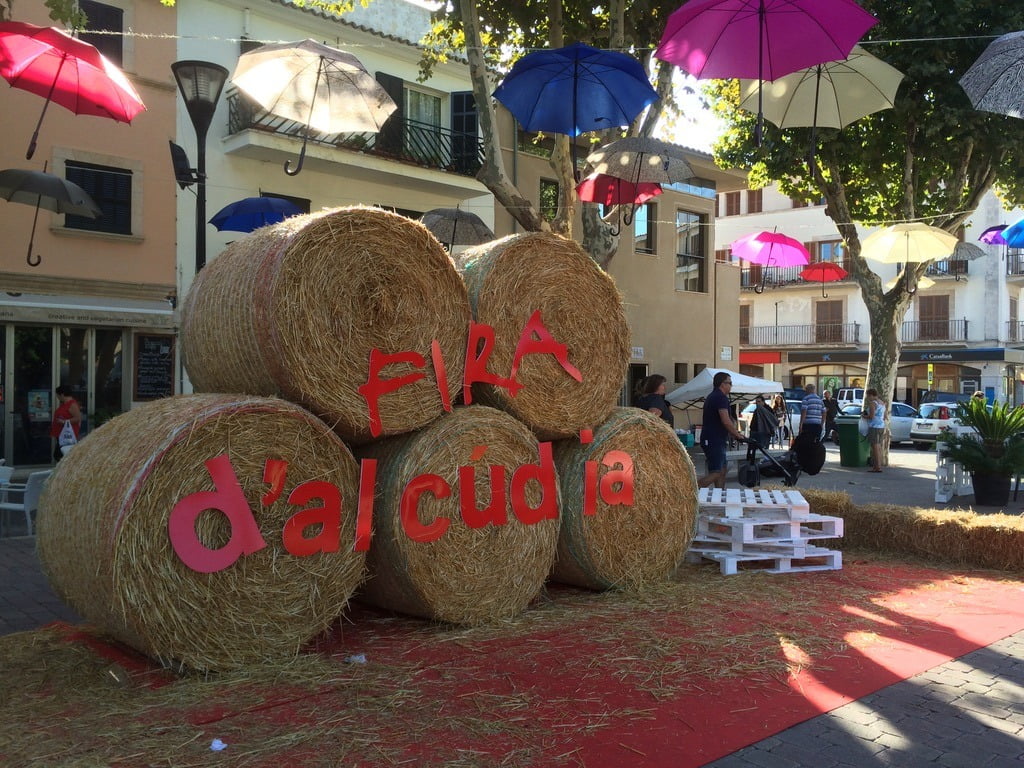
Early October
One of the largest of the autumn fairs in the north. Visit to see animals, agriculture, local produce, music and of course a fair of the fun variety.
Dia de les Verges (Virgin’s Day)
20th October
The tradition of serenading a sweetheart on this day is not as widely practised as it was however, in Alcudia for example there is still a group of musicians from various musical backgrounds who gather to sing to the town’s female population. This very sweet custom is aptly accompanied by the sharing of sugary donuts – or bunyoles – which are found in most weekly markets especially at this time. They are also made at all the local schools for the kids to celebrate the Dia de les Verges.
Halloween and All Saint’s day
Over the past 10 years or so, Halloween has gathered traction and it’s not uncommon to see local children dressing up for Trick or Treat or heading to the town for a halloween themed party. The next day, All Saint’s Day is a quiet one when people head to the local cemetery with flowers, traditionally a pot full of Chrysanthemums, to pay respects and remember family members who have passed.
You may also notice strings of sweets arranged like a sugared rosary. It’s a deep-rooted custom that, for the feast of All Saints, godparents give these to their godchildren, grandparents to their grandchildren and parents to their young children, for them to wear around their necks. And of course eat.
November
Dijous Bo, Inca
Throughout November
Just a 20–minute drive from the north, Inca offers its string of lively market days with a calendar of cultural events throughout the whole of November. Named Dijous Bo – Good/Great/Grand Thursday – markets with animals, artesans, agriculture and industry line the packed streets. Each Thursday follows a theme and culminates with the final one towards the end of the month, which is preceded with Dimecres Bo (good/great/grand Wednesday). It’s the Autumn fair of all Autumn fairs on the island.
Pumpkin Fair, Muro
Always held on the second Sunday of November, the town of Muro showcases its local Pumpkin to celebrate the autumn fair. Starting on the Friday before, a variety of cultural and gastronomic events with the carabassa (pumpkin) playing a leading role keep the town busy. On the Saturday, a wine tasting is held at the Cloisters. For the little ones, there’s a parade of pumpkin lanterns.
On the final day of celebrations, the pumpkin competition sees locals present their produce, the largest ever native pumpkin shown at this fair weighed in at 140kg and the largest non-native, a staggering 334kg. Something to aim for this autumn?
La Fira, Pollensa
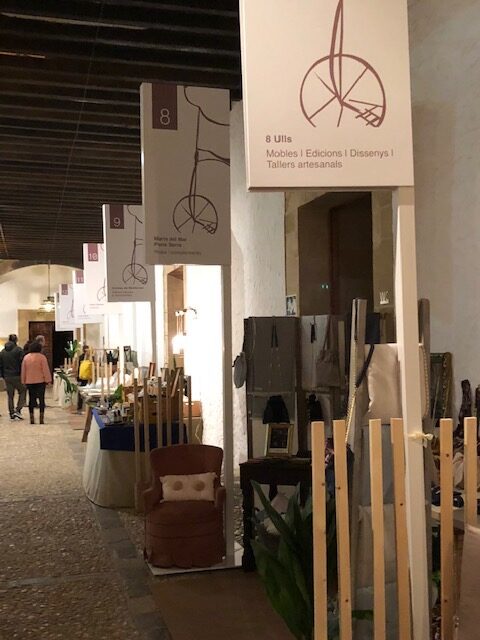
Usually the second Sunday in November, the Fira of Pollensa has something for everyone. An amazing artesan fair is always popular, in its stunning location at the Claustre and the attached Santo Domingo Church setting. There is also a funfair, produce market, a string of events and live music as well as, on the Sunday, animals that local farmers bring to show off including a sheepdog exhibition.
Fira de Tardor (Autumn Fair), Sa Pobla
Held over the last weekend of November, Sa Pobla’s version of the Autumn Fair revolves around the world of rice. A programme of sporting, cultural and musical activities are complemented with the funfair and animal shows as well as an agricultural and trade fair. Also worth noting is the weekend before, when there is the Meeting of the Giants and of the Xeremiers (pipers).
December
Christmas
Christmas in Mallorca, at least in the north and away from Palma, is a quiet affair, much quieter than in the UK. Gifts are generally given by the Kings in January so the focus is on a dinner with friends and family on Christmas Eve (Nochebuena) and a long family dinner on Christmas day, with some presents.
Throughout December, there are Choral concerts in towns across the north but perhaps the most notable is the Sibilla. Listed on UNESCO’s List of Intangible Cultural Heritage of Humanity, the chant is performed in churches all over Mallorca and is sung by a boy or girl accompanied by two or more altar boys and girls. During the chant, the singer walks towards the altar carrying a sword upright, in front of his/her face.
No matter where you are in the North of Mallorca, and no matter what time of year, there is always something going on somewhere. The fiestas in Mallorca – not forgetting the traditional firas – are the life of the island so be sure to explore and enjoy.
See our What’s On page for agendas for each fiesta as soon as they are released.

